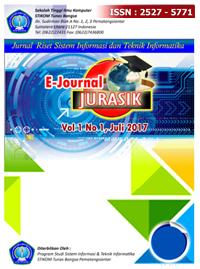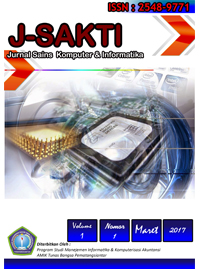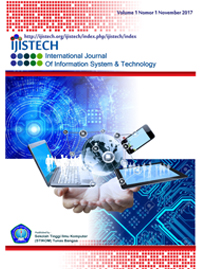Teknik Data Mining dalam Mengelompokkan Produktivitas Padi Menurut Provinsi Menggunakan K-Medoids
Abstract
Full Text:
PDFReferences
A. K. Wardhani, “Implementasi Algoritma K-Means untuk Pengelompokkan Penyakit Pasien pada Puskesmas Kajen Pekalongan,” Jurnal Transformatika, vol. 14, no. 1, pp. 1–8, 2016.
I. Parlina, A. P. Windarto, A. Wanto, and M. R. Lubis, “Memanfaatkan Algoritma K-Means dalam Menentukan Pegawai yang Layak Mengikuti Asessment Center untuk Clustering Program SDP,” CESS (Journal of Computer Engineering System and Science), vol. 3, no. 1, pp. 87–93, 2018.
S. Sudirman, A. P. Windarto, and A. Wanto, “Data Mining Tools | RapidMiner : K-Means Method on Clustering of Rice Crops by Province as Efforts to Stabilize Food Crops In Indonesia,” IOP Conference Series: Materials Science and Engineering, vol. 420, no. 12089, pp. 1–8, 2018.
R. W. Sari, A. Wanto, and A. P. Windarto, “Implementasi Rapidminer dengan Metode K-Means (Study Kasus : Imunisasi Campak pada Balita Berdasarkan Provinsi),” KOMIK (Konferensi Nasional Teknologi Informasi dan Komputer), vol. 2, no. 1, pp. 224–230, 2018.
M. G. Sadewo, A. P. Windarto, and A. Wanto, “Penerapan Algoritma Clustering dalam Mengelompokkan Banyaknya Desa/Kelurahan Menurut Upaya Antisipasi/ Mitigasi Bencana Alam Menurut Provinsi dengan K-Means,” KOMIK (Konferensi Nasional Teknologi Informasi dan Komputer), vol. 2, no. 1, pp. 311–319, 2018.
D. A. S. Simamora, M. T. Furqon, and B. Priyambadha, “Clustering Data Kejadian Tsunami Yang Disebabkan Oleh Gempa Bumi Dengan Menggunakan Algoritma K-Medoids,” vol. 1, no. 8, pp. 635–640, 2017.
W. A. Triyanto, “ALGORITMA K-MEDOIDS UNTUK PENENTUAN STRATEGI PEMASARAN,” vol. 6, no. 1, pp. 183–188, 2015.
M. T. Furqon, A. Ridok, and W. F. Mahmudy, “Paralelisasi Algoritma K-MedoidS Pada General Purpose menggunakan Open Computing Language,” Konferensi Nasional Sistem Informasi 2015, pp. 1–7, 2015.
Defidelwina, A. Ariyantodan, and Y. Aini, “Strategi peningkatan produksi dan produktivitas padi sawah di kabupaten rokan hulu,” Prosiding Seminar Nasional dan call for papers, vol. VII, pp. 1266–1275, 2017.
Vandana Aditya Putra Sangga, “No Title,” 2015.
D. F. Pramesti, M. T. Furqon, and C. Dewi, “Implementasi Metode K-Medoids Clustering Untuk Pengelompokan Data Potensi Kebakaran Hutan / Lahan Berdasarkan Persebaran Titik Panas ( Hotspot ),” vol. 1, no. 9, pp. 723–732, 2017.
H. Zayuka, S. M. Nasution, and Y. Purwanto, “Perancangan Dan Analisis Clustering Data Menggunakan Metode K-Medoids Untuk Berita Berbahasa Inggris,” e-Proceeding of Engineering : Vol.4, No.2 Agustus 2017, vol. 4, no. 2, pp. 1–9, 2017
DOI: http://dx.doi.org/10.30645/senaris.v1i0.71
Refbacks
- There are currently no refbacks.
 








